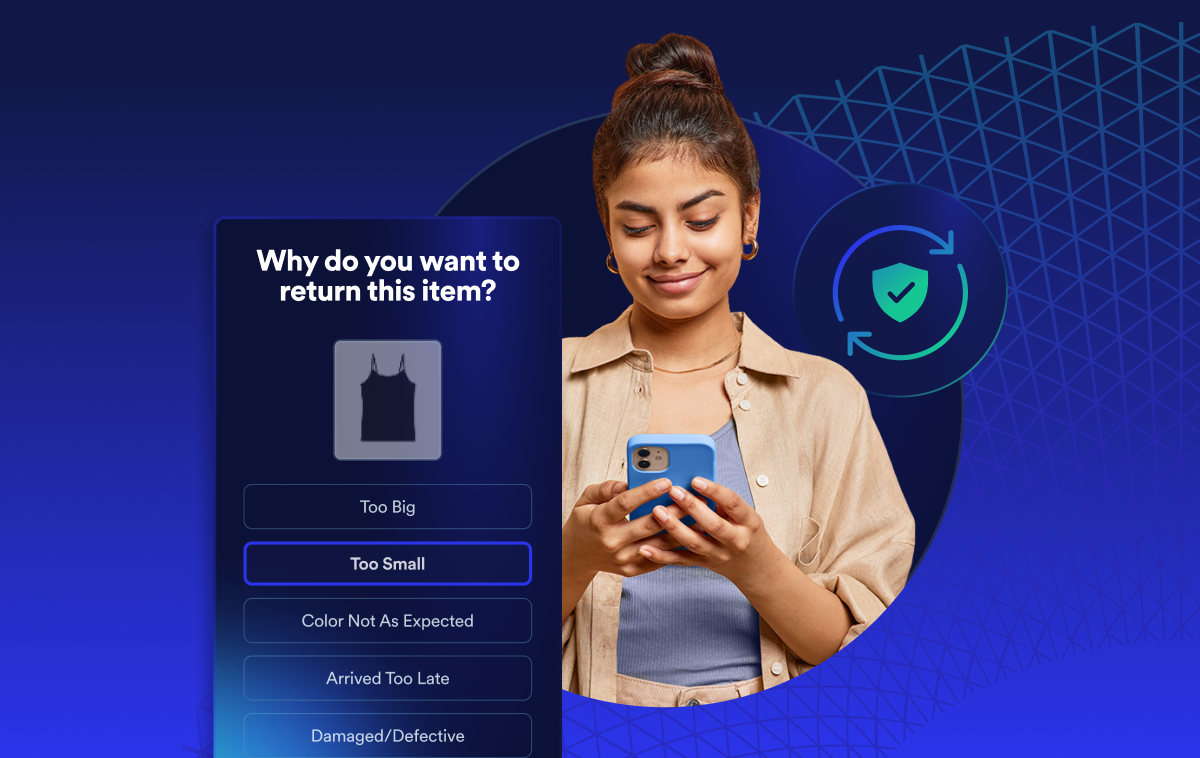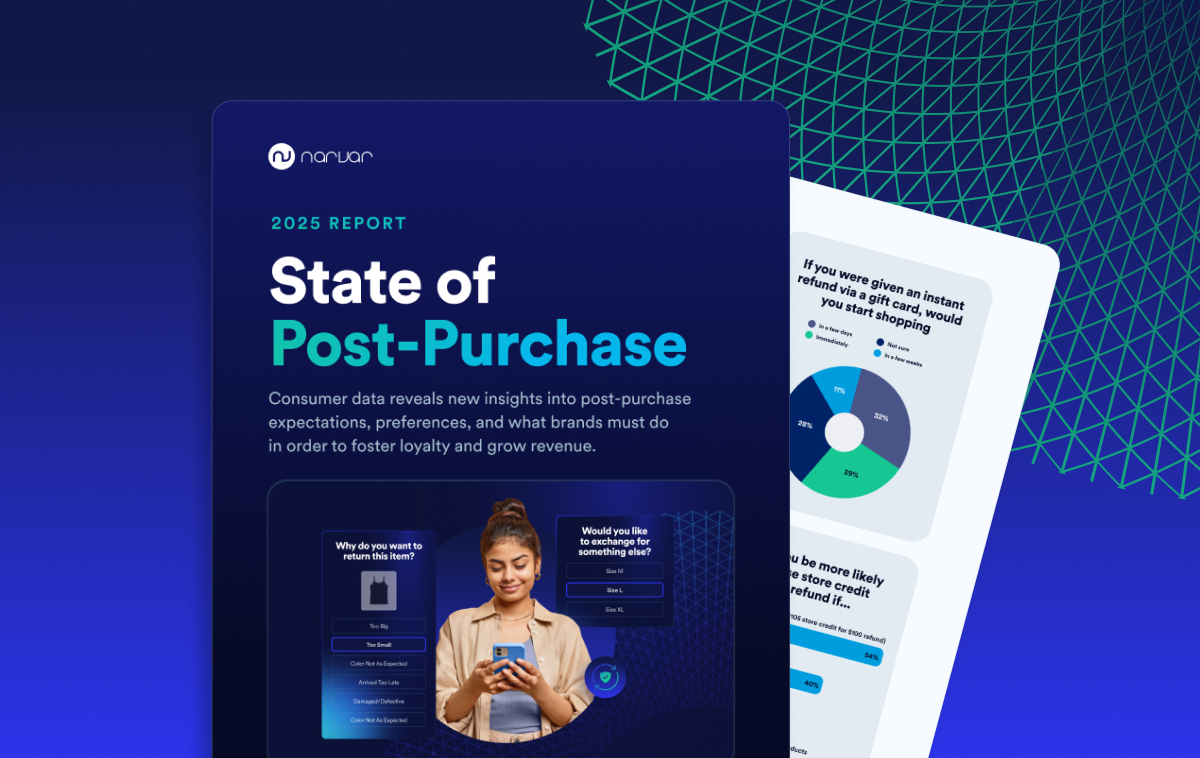
AI-powered delivery date estimates to boost conversion
Give shoppers peace of mind and protect and grow your bottom line
Personalized tracking experiences to build brand loyalty
Returns and exchanges management to mitigate fraud and reward best customers
Proactive communication to drive customer lifetime value
Delivery claim management to tackle fraud and build trust
Shipping Insurance for E-Commerce: A Complete Protection Guide

In today’s ecommerce reality, winning the sale is just the beginning. From porch piracy to delivery damage to supply chain chaos, the final mile has become the most vulnerable – and most expensive – stage of the consumer journey. When things go wrong, the retailer usually pays the price.
That’s why shipping protection for e-commerce matters. With package theft and shipping damages on the rise – the financial loss from theft alone totaled $16 billion in 2023 – offering robust shipping protection has become essential. Shipping insurance for e-commerce provides financial protection against lost, damaged, or stolen packages during transit. For retailers, it represents a critical safety net in an increasingly complex delivery landscape. It’s not just another cost center, but a revenue-generating, loyalty-building, margin-protecting asset. It’s also a critical safety net in an increasingly complex delivery landscape.
Smart retailers are no longer asking if they should offer protection – they’re asking how to do it better. Many are now offering insurance as an add-on service to enhance the consumer experience. This protection extends beyond the basic carrier coverage, which often has significant limitations and exclusion clauses that leave merchants vulnerable. Package protection gives both retailers and shoppers peace of mind throughout the delivery process.
This guide explains everything retailers need to know about shipping insurance options, costs, coverage details, and implementation best practices. It breaks down why comprehensive package protection is now a must-have in your post-purchase strategy, and how to implement it in a way that boosts your bottom line while building long-term consumer trust.
What you’ll learn in this article:
- Types of package protection options
- Benefits of shipping insurance for retailers
- What’s covered: Protection details and exclusions
- Implementing shipping insurance for your business
- Measuring shipping insurance success
- Why retailers should offer shipping insurance
- Shipping protection FAQs
Types of package protection options
Lost package coverage
Lost package coverage protects retailers from the financial impact of shipments that never arrive. According to industry data, approximately 5 - 7% of all packages experience some form of delivery issue, with lost packages accounting for a significant portion of these incidents. Offering lost package coverage can reduce customer service inquiries about missing deliveries by providing a clear resolution path. The most effective solutions include:
- Automated tracking verification
- Proactive notification systems
- Streamlined claims processes
- Quick reimbursement or replacement options
Comprehensive lost package coverage includes tracking and verification systems to confirm delivery status, reducing the potential for fraudulent claims while ensuring legitimate issues are addressed promptly.
Damaged package insurance
Damaged package insurance covers the cost of items that arrive broken or compromised during shipping. This is particularly important for retailers selling fragile or high-value merchandise. With damaged package insurance, retailers can offer hassle-free replacements without absorbing the costs. The claims process for damaged package insurance should be simple and straightforward for shoppers, typically requiring:
- Photo documentation of damage
- Order verification
- Minimal paperwork
- Quick approval process
Modern solutions automate much of this workflow, reducing the administrative burden while improving the shopper experience.
Stolen package protection
Stolen package protection addresses the growing problem of porch piracy affecting e-commerce deliveries. According to security research, a staggering 120 million packages are stolen annually in the United States alone. Retailers who offer stolen package protection create a safety net for consumers concerned about theft. This coverage typically includes:
- Verification processes to prevent fraudulent claims
- Prompt replacement of stolen items
- Options for alternative delivery methods
- Integration with delivery confirmation systems
By offering stolen package protection, retailers can differentiate their post-purchase experience while reducing the financial impact of theft-related losses.
Benefits of shipping insurance for retailers
Reduced operational costs
Shipping protection plans cover a wide range of delivery issues that can impact consumer satisfaction. By transferring the financial risk to an insurance provider, retailers can:
- Minimize replacement costs for lost or damaged items
- Reduce customer service workload related to shipping issues
- Decrease the need for goodwill refunds and credits
- Lower chargeback rates related to delivery problems
The right shipping protection solution integrates seamlessly with your existing e-commerce platform, creating operational efficiencies while improving the bottom line.
Enhanced consumer experience
A shipping guarantee builds consumer confidence in your delivery process and post-purchase experience, and consumers are increasingly blaming retailers – not shippers – for delivery issues.
Shoppers are more willing to purchase shipping protection, especially on more expensive items. In the past year, 37% of consumers have purchased insurance for an online order. More than half of consumers see value in protecting their purchases — regardless of the price point. The most effective shipping guarantee programs are backed by comprehensive protection policies that provide:
- Clear terms and conditions
- Simple claims submission process
- Rapid resolution timeframes
- Multiple coverage options
Competitive advantage
Delivery insurance covers multiple risks including loss, damage, and theft during the shipping process. By offering this protection, retailers can:
- Differentiate from competitors with basic or no shipping protection
- Build stronger consumer relationships through enhanced service
- Increase conversion rates, especially for high-value purchases
- Improve shopper retention and lifetime value
Retailers who offer shipping protection see higher consumer loyalty and repeat purchase rates compared to those who place the shipping risk entirely on shoppers. That’s why shipping insurance for small business and corporate giant retailers is so critical.
Potential new revenue stream
Offering shipping insurance for e-commerce can create a new revenue stream for retailers. By partnering with insurance providers, retailers can earn a percentage of the insurance payments collected from shoppers. This additional income can help offset shipping costs or contribute to overall profitability. The revenue share model allows retailers to benefit financially while providing added value and peace of mind to their shoppers.
What’s covered: Protection details and exclusions
How does shipping insurance work within e-commerce platforms?
Modern package protection solutions provide automated claims processing and quick resolution. The best systems integrate directly with popular e-commerce platforms through:
- API connections
- Pre-built plugins
- Custom implementation options
- Seamless checkout integration
This integration allows for real-time protection offers during the checkout process and streamlined claims management when issues arise.
Claims management for lost packages
Efficient claims management for lost packages is essential for maintaining consumer satisfaction. The most effective solutions offer:
- Self-service claims portals: These allow consumers to initiate and manage their claims independently, reducing workload on customer service teams.
- Automated verification processes: These systems use data and algorithms to quickly validate claims, minimizing review and speeding up the overall process.
- Clear status updates: Regular, transparent communication keeps shoppers informed about the progress of their claims, reducing anxiety and support inquiries.
- Quick resolution timeframes: This ensures that valid claims are settled promptly, enhancing consumer satisfaction and trust in the service.
Automated claims management for lost packages reduces the burden on customer service teams while providing consumers with faster resolutions.
Post-purchase protection experience
Post-purchase protection encompasses shipping protection and other services that enhance the delivery experience. A comprehensive solution should include:
- Real-time tracking information
- Proactive issue identification
- Clear communication about coverage
- Simple claims submission process
Implementing post-purchase protection can significantly improve consumer loyalty and lifetime value by addressing one of the most common sources of shopping frustration.
Implementing shipping insurance for e-commerce
Choosing the right shipping insurance provider
When selecting a package protection provider, consider:
- Coverage options and exclusions: This ensures the provider offers comprehensive protection that aligns with your product range and shipping risks.
- Claims process efficiency: Streamlined, user-friendly claims procedures minimize consumer frustration and administrative overhead.
- Integration capabilities with your existing systems: A solution that seamlessly integrates with your e-commerce platform and order management systems ensures smooth operations.
- Pricing structure and profit potential: Evaluate the cost-effectiveness of the insurance and any revenue-sharing opportunities that could benefit your business.
- Shopper experience and interface: An intuitive interface to manage protection and claims benefits both you and your shoppers.
- Reporting and analytics features: Robust reporting tools help you track performance, identify trends, and make data-driven decisions.
The ideal solution offers comprehensive coverage while simplifying administration for both your team and your shoppers.
Integration best practices
Offer package insurance at checkout as well as other touchpoints. Embed the shipping insurance for e-commerce offer across the post-purchase journey – cart page, checkout, order confirmation email, or tracking page – to maximize opt-in. Retailers who present the option early and often see higher opt-in rates, especially for high-value orders.
Clearly communicate why consumers should buy shipping insurance
Shoppers will wonder “is shipping protection worth it”? To make the case, avoid jargon and instead use consumer-focused messaging that reinforces trust and value. Consumer-centric language boosts confidence, which increases conversion and reduces cart abandonment. Some examples include:
- “Protect your order from theft, loss, and damage.”
- “Get peace of mind – resolve any issue in just a few days.”
Train customer service teams on shipping insurance claims processes
While the claims flow is self-service, a well-prepared team reinforces trust and deflects unnecessary tickets. Be sure they know what’s covered, can easily find claim status, and can confidently communicate value to consumers.
Monitor performance metrics and adjust as needed
Use insights to A/B test offer language, placement, and pricing. Key success metrics include:
- Opt-in rates (target: 40 - 65%)
- Claim submission and resolution times
- Customer service ticket deflection
- Incremental revenue generated
- Consumer satisfaction post-claim
Consider bundling protection with premium services
Bundling shipping protection with other post-purchase benefits can significantly boost adoption, perceived value, and margin. Bundle protection with:
- Premium shipping: “Protect your express delivery from theft, loss, and damage.”
- Loyalty perks: “Members get free shipping protection on all orders.”
- Carbon-neutral shipping: “Offset emissions and protect your package with a single click.”
- Concierge delivery: Create a premium post-purchase tier that includes peace of mind.
Measuring shipping insurance success
Tracking metrics helps you evaluate both financial outcomes and consumer impact of your shipping protection program. Track the following KPIs:
Adoption rate (percentage of orders with protection)
This is the leading indicator of performance, measuring how many consumers opt in to protection and the correlating increase in revenue and reduced liability exposure. Improve it by testing placement (cart, checkout, confirmation), refining messaging to emphasize peace of mind, and considering defaulting the toggle to “on” (with opt-out transparency).
Claims frequency and resolution time
Track how often claims are submitted and how long it takes to resolve them. High claim frequency may signal fulfillment or delivery issues that need to be addressed. Quick resolution (target: 3 - 5 days) drives consumer satisfaction and prevents repeat inquiries.
Customer satisfaction scores for claims handling
Use CSAT or NPS surveys post-claim to measure how shoppers feel about the resolution process. A seamless, respectful claims process can turn a negative delivery experience into a loyalty driver. What to track:
- CSAT after claim resolution (goal: >85%)
- NPS variance for protected vs. unprotected orders
- Percentage of claimants who repurchase
Revenue generated from protection offerings
Shipping protection can be a high-margin upsell, especially at scale. Retailers can retain a percentage of each protection sale, unlocking incremental revenue with zero fulfillment cost, helping to offset operational costs from support, replacements, and re-ships.
Metrics to track:
- Gross revenue protection per period
- Margin contribution from protection
- Attach rate by order value, category, or consumer segment
Reduction in CS tickets related to shipping issues
Shipping protection should drive down support volume by resolving common delivery concerns proactively and automatically. Every ticket deflected is time saved and cost avoided. Self-service portals also give consumers real-time updates and control.
Why retailers should offer shipping insurance
Package protection for e-commerce has evolved from optional add-ons to essential components of a competitive post-purchase strategy. By implementing comprehensive shipping protection, retailers can reduce costs, enhance the consumer experience, and build stronger brand loyalty. And when that package doesn’t find its way to an eager consumer’s doorstep for whatever reason, that disconnect can become a moment of care, not frustration.
The most successful retailers integrate shipping protection seamlessly into their purchase experience, creating a seamless relationship-building moment that addresses consumer concerns while also protecting the bottom line. As e-commerce continues to grow, the importance of robust shipping protection will only increase. For more information on implementing shipping protection for your business, explore our related resources on returns management and post-purchase experience optimization.
To learn more about shipping insurance, click here.
Shipping protection FAQs
What’s the difference between carrier insurance and third-party shipping insurance?
Carrier insurance (USPS, UPS, FedEx) typically offers limited coverage (often $100) with restrictive claims processes and exclusions. Third-party insurance can provide more comprehensive shipping coverage, usually providing higher coverage limits, more comprehensive protection, simpler claims processes, and often costs less for higher-value items. Many retailers choose third-party options for better overall protection and shopper experience.
How much does shipping insurance for e-commerce typically cost?
Shipping insurance cost typically runs between 1 - 3% of the declared value of the shipment. For example, a $500 package might cost $5 - 15 to insure. Volume discounts are often available for retailers with high shipping volumes. Some third-party providers offer tiered pricing that becomes more cost-effective as package values increase.
How long do consumers have to file a claim for damaged or lost packages?
Most shipping insurance providers require claims to be filed within 15 - 60 days of the expected delivery date. USPS allows claims within 60 days, while UPS and FedEx typically require claims within nine months. Third-party insurance providers often have more flexible timeframes, but prompt reporting (within 24 - 48 hours) of issues is always recommended.
How can retailers present shipping insurance to shoppers without hurting conversion rates?
Present shipping protection as a value-added service rather than an upsell. Highlight the benefits (peace of mind, faster resolution) using simple language. Position it at the right moment in checkout, after shipping method selection. Test different price points and messaging. Some retailers find that offering free basic protection can actually increase conversion rates.
What documentation is needed to file a successful shipping insurance claim?
Successful claims typically require: proof of value (invoice or receipt), proof of shipping (tracking number and shipping label), clear photos of packaging and damage (for damaged items), detailed description of the issue, and confirmation of delivery status. Having a systematic approach to collecting and storing this documentation streamlines the claims process.
Is shipping insurance worth it for low-value items?
For items under $100, standard carrier coverage may be sufficient. However, even for lower-value items, third-party insurance can be worthwhile when considering the total cost of replacement, reshipping, customer service time, and potential impact on consumer loyalty. Many retailers set minimum thresholds (typically $50-75) for when they automatically add protection.
Get more insights from the experts
GET STARTED
Power every moment after the buy
Build trust. Protect margins. Drive growth — “Beyond Buy.”




















